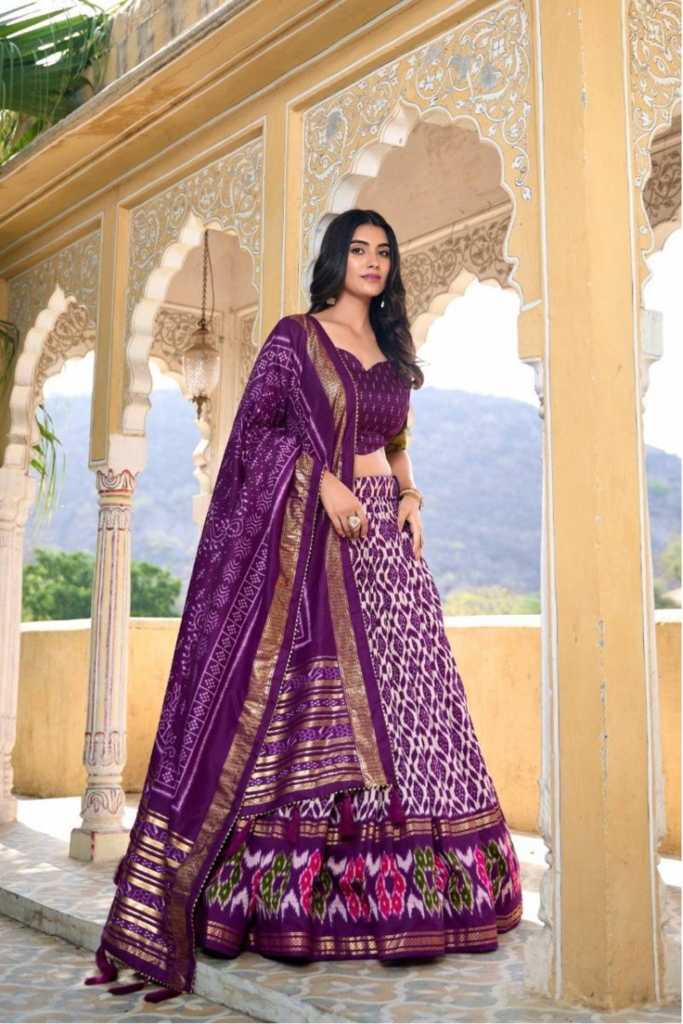Going after the different aims of life young people sometimes face a challenge like obstinate selecting of the lehenga. One of the most important factors to consider when choosing a lehenga is how well it complements one’s skin tone. In the following article, you can uncover the tips on buying a lehenga that perfectly matches your natural beauty and skin color, thus, you shine while you are in every event.
Understanding Skin Undertones
The first and foremost thing before finalizing the lehenga is to know what your skin undertone is. The skin undertone can be warm, cool, and neutral, and on which type individuals fall is found upon making the veins test on their wrists standing in the natural light. It is a typical case that, when the vein is green the skin is warm, if blue or purple then this is cool and the combination of them means the skin is neutral.
Lehenga Colors for Warm Undertones

According to cool and warm police, people who have warm undertones in general have golden, peachy, or yellow tones in their skin. Through the week-loved and trendy options there are as well in the baju being relevant to the wedding attire will be:
- Blood red
- Carrot orange color
- Custard or sunny yellow
- Zenith peach and rich coral
- Soft pink in most tones
- Olive green
- Warm browns
By the means of the warm colors, the natural skin warmth is enhanced and a harmonious appearance is attained. They would most likely come across Lehenga Wholesale in stores that sell a wide variety of designs, all of which the majority is warm-toned, and of course, at cost-effective prices.
Lehenga Colors for Cool Undertones

Cool undertones then consist of pink, red, or blue tones in the skin. People with cool undertones look best in lehengas that are in cool shades including the following:
- Navy blues
- Jade greens
- Violets
- pix
- Lavenders
- Silver
- White
These colors will take the natural coolness of the skin to another level, creating a strong contrast. They are also to avoid any colors that are too warm, or close to the earth, as with this kind of skin, they could clash.
Lehenga Colors for Neutral Undertones

Neutral undertones are characterized by a balance between warm and cool colors in the skin. This flexible skin tone allows the user to choose from a wide spectrum though. Especially everything: namely, all the trendy colors that we mentioned before such as:
- Navy blue
- Teal
- Jade green
- Peach and Roza
- Burgundy
- Mustard yellow
- Taupe
Most people who have a neutral skin tone can wear both warm and cool colors that are worn effectively. Thus, they can also choose from various styles and designs offered in Lehenga Wholesale collections by their manufacturer.
Considering Skin Depth
Besides skin undertones, skin depth should be a top concern when choosing a lehenga. It is also the top reason to do so. The brighter or darker one’s body looks due to the pigmentation is called skin depth. General sim
Fair Skin
When fair-skinned people choose what to wear, they might want to try lehengas that come in pastel colors. Bright colors like baby pink for day and green mint for night will give you a very light and airy appearance. On the other hand, deep colors such as royal blue, emerald green, and ruby red will add some nice dark and muted finishing to the skin.
Medium Skin
In the medium tone, there is a wide variety of colors that look best. The choice of bright and the option of not-as-bright colors is for them. One can look bright in fuchsia/ turquoise/ tangerine and still have a lively feeling expressed. If medium tone is your skin tone, then you can never go wrong with rust (for warm), olive, or mustard colors (for cool).
Dark Skin
Dark-complexioned individuals have the benefit of experimenting with striking and loud colors that grab the attention of everyone in the room. Flashy shades like sky blue, sapphire, citrus green, and hot pink can also play a role in complementing the look to create a bold contrast against dark-colored skin.
Fabric and Embellishments
The one who is picking a casual lehenga gives consideration to the implications of more than simply colors; he/she should also look at the fabrics and decorative elements used in the outfits. If colors of certain fabrics and the way they will get along with the skin are taken into consideration then different skins will look different in the same fabric. For instance, shiny materials like silk or satin can send upon color an intensity-light effect. Yet, matte fabrics like cotton or georgette may turn down the colo
Decorations such as sequins, beads, or embroidery are other elements that need to be taken into account. The color of the piece can change with the embellishments on the lehenga. For warm tones, gold adds a sense of luxury, while silver makes it more cool. For the neutral, both gold and silver are well liked.
Trying Before Buying
While that feels like an excellent starting set of recommendations, customers would be wise to traipse about different lehengas before coming up with the final decision. Many different lighting conditions can contribute to the color that is finally seen by the beholder, wherefore, it is strongly advised to always try the lehenga on in the natural light. Additionally, it does work seeking opinions from the acquaintances or family you can count on, they would give you feedback on which type and style su
Conclusion
From the proper use of color tones to highlights, skin layering, fabric, and embroidery motifs are some good practices that can boost the stylish look of a lehenga according to the skin tone. Try out all these tips and see the wonderful effect that a beautifully-coordinated lehenga can bring to your wardrobe.

